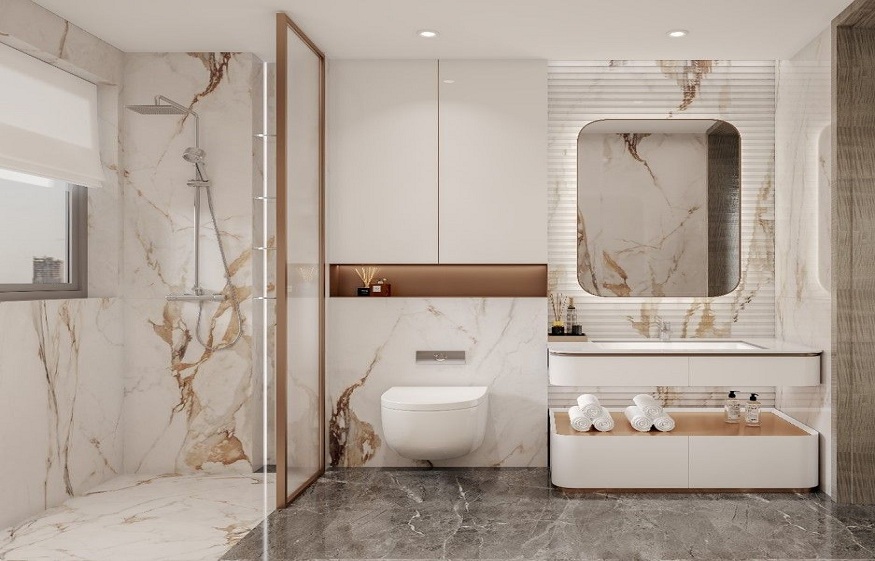The bathroom is a space where we start and end our day, hence the importance of creating an environment that is both functional and aesthetic. The choice of tiles is crucial in this room, as it must combine style, durability and ease of maintenance.
In this article, we’ll explore how to choose the perfect tiles for your bathroom , taking into account current trends and the specific needs of your renovation project.
Why choose tiling in a bathroom?
Tile is a popular choice for bathrooms and for good reason. It could also be the perfect solution for your renovation project:
Water resistance
The bathroom is a naturally humid environment, and tiles excel in their ability to resist water . Unlike other materials, they do not warp or degrade when exposed to moisture, making them a perfect covering for the walls and floors of this room.
Sustainability
Tile is known for its longevity . When installed correctly, it can last for decades without losing its shine or functionality. Its resistance to daily wear and tear makes it a wise choice for high-traffic areas like bathrooms.
Aesthetics and versatility
With a wide range of styles, patterns and colours available, bathroom tiles offer great aesthetic flexibility. Whether you’re looking for a modern, minimalist or traditional look, you’ll find options that perfectly match your design vision.
Ease of maintenance
When it comes to cleaning and maintenance, tile is hard to beat. A simple regular wipe down is all it takes to maintain its appearance, and it resists stains, which is a major plus in a space where splashes are common.
These characteristics make tiles an ideal choice for those who wish to combine functionality and design in their bathroom, ensuring both a hygienic and aesthetically pleasing environment.
The different types of bathroom tiles
Ceramic
Ceramic tile is known for its versatility and affordability . It comes in a variety of colors and finishes, but can be less durable than other materials.
Porcelain
Porcelain is denser and less porous than ceramic, making it ideally resistant to water and stains.
Natural stone
Natural stone, such as marble or granite, offers a luxurious look to any bathroom. However, it requires more rigorous maintenance to prevent stains and damage.
Current trends in bathroom tiles
A look back at some trends in bathroom renovation and decoration :
Colors and patterns
Neutral colors like white, gray and beige dominate current trends, often enhanced with geometric or floral patterns to add character to the space.
Light-colored bathroom tiles
Formats and sizes
Large tiles continue to grow in popularity as they create a sense of space and minimise the number of exposed joints, making cleaning easier.
Consider space
The choice of colours and formats can influence the perception of space. Light tones and large formats can visually enlarge a small bathroom.
Evaluate the terms of use
Make sure the tile you choose is water and moisture resistant, especially in areas like the shower.
Choose non-slip tiles
When renovating a bathroom , safety is an often underestimated but crucial aspect. Choosing non-slip floor tiles can prevent many household accidents. A slippery floor can be dangerous, especially in a humid environment like the bathroom.
Anti-slip tiles are designed to provide better grip, reducing the risk of falls. These tiles are specially treated or textured to increase friction, even when wet, ensuring optimum safety for the whole family.
Consider the budget
Cost can vary greatly depending on the material. Compare options to find a good balance between cost, quality, and aesthetics.
Surface preparation
Proper preparation is essential to ensure a successful installation.
Laying techniques
Choose between glued installation and sealed installation, depending on the specific features of your bathroom and your preferences.
Finishes and joints
Joints must be chosen carefully to prevent water infiltration. Opt for moisture-resistant joints to extend the life of your tiles.
The Importance of Waterproofing
When installing tiles in your bathroom, waterproofing the surfaces is an essential step to ensure the longevity and effectiveness of your covering. This is especially important for the walls where the wall tiles are installed, as well as for the joints.

